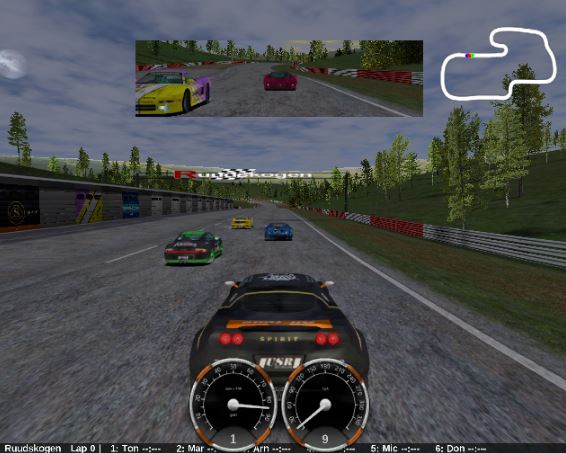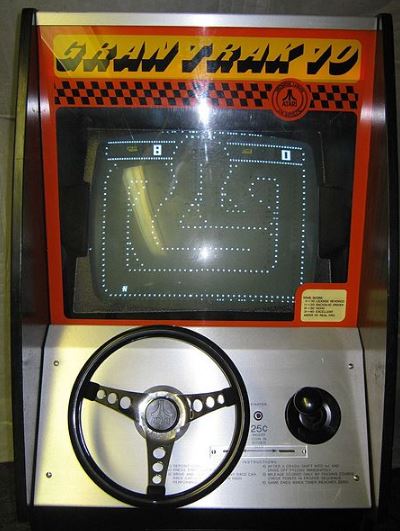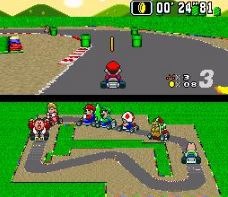Automotive racing was a driving force behind the development and popularity of the video game industry for decades, from Gran Turismo to Need for Speed to Mario Kart. After all, one of the most enticing parts of virtual reality is the reproduction of real-life experiences, so it’s no surprise that car racing would be popular. That’s why over 2,000 racing video games have been released on consoles, handhelds, arcades, and digital platforms in the last 40 years.
But it all began with a single game: Atari’s Gran Trak 10–the first-ever car racing video game–debuted way before the photo-realistic simulations we have today, paving the way for the future of virtual racing.
Atari’s Gran Trak 10–the first-ever car racing video game–debuted way before the photo-realistic simulations we have at present, paving the way for the future of virtual racing.
Learn more about the first car racing video games below.
A Historical Overview of Racing Video Games
Gran Trak 10, released in 1974, is widely regarded as the first racing video game. The Gran Trak 10 arcade cabinet, designed and sold by Atari, was notable for its usage of a steering wheel as a controller and pedals and a gear change. Its top-down design used a simple dot pattern (diode-based ROM) to create a black-and-white course that the player had to complete against the clock.
The following year, Taito released Speed Race, which included a driving wheel and an innovative scrolling screen.
The game Night Driver, which used comparable white dots for the track with a plastic overlay of a car, made progress in 1976 when Atari shifted to a first-person perspective.
In most early games, players competed against the clock, attempting to complete laps within a set time restriction. AI competitors were not introduced until around this period, which led to multiplayer racing.
However, it took nearly a decade for the virtual vehicle racing craze to catch on, with Namco’s Pole Position becoming the highest-grossing arcade hit of 1983. Its style and perspective set the bar high for future games. It even has its little animated series.
The First Car Racing Video Games
Gran Trak 10 (1974)
Atari’s 1974 entrance into the world of racing games was this black-and-white top-down racer. As can be seen, the beastly cabinet weighed more than 400 pounds, and the graphics were highly limited. Players must avoid touching the white dots that trace the track’s edges with their steering-wheel-controlled car sprite.
Night Driver (1976 Arcade, 1978 Atari 2600)
Night Driver was famous for being the first driving game to incorporate a behind-the-wheel perspective, which would become widespread in racing games and lead to first-person and dashboard perspectives. You can nearly see how the 2600 graphics represent the thrills of driving after the sun sets if you squint a little.
Pole Position (1982)
One of the most significant racing games was Namco’s arcade racer. It was so successful that a Saturday morning cartoon was created based on it.
The vibrant, three-dimensional graphics and fluid motion set the bar for racing games. The 2600 version of the game looked like other 2600 arcade conversions, but it did a decent job approximating the original.
Rally X (1980)
Namco’s Rally X was a multi-directional top-down racing game with several paths and rival racers. The goal was to collect flags while avoiding collisions with other vehicles as you raced through the streets. It also had a “radar” and a limited quantity of gasoline.
Hang On (1985)
SEGA’s Hang On took the third-person view of arcade racers and replaced the race car with a motorcycle. The arcade cabinet was much cooler because it was controlled by a motorcycle controller that players sat on and used to lean into turns. SEGA’s “Super Scaler” sprite technology was used, as well as gorgeous, colorful 16-bit sprites.
Hard Drivin’ (1989)
One of the earliest racers to use polygonal visuals was Hard Drivin’. The driving lived up to the name, and the home version may well have been dubbed “Impossible Drivin’.” The SEGA Genesis console’s relatively simple polygons still required a lot of power at the time, and most players spent their time crashing as spectacularly as possible or trying to run over the low-res cow.
Super Mario Kart (1992)
For the Super NES, Super Mario Kart generated a very successful series of games and clones and knock-offs. Super Mario Kart took Nintendo’s Mario characters out of the Mushroom Kingdom’s side-scrolling realm and into the fast-paced world of kart racing, using Super Nintendo’s “Mode 7 scaling” to imitate movement along a 3D plane (a method also employed expertly in F-Zero for SNES).
Daytona USA (1993)
Daytona USA was a SEGA polygonal racing game that competed with Namco’s Ridge Racer, released in arcades the same year. Daytona was more detailed than its predecessor, Virtua Racer, and deluxe versions of the cabinet allowed up to eight players to compete head-to-head. It is also a fantastic example of an “arcade racer,” as it was among the highest-grossing arcade games of all time.
Stunt Race FX (1994)
FX Stunt Race Stunt Race FX is the second game to use the Super FX processor, and it’s a cartoonish, colorful 3D racer that appears rudimentary by today’s standards. The fact that it runs on a Super NES shows how clever the Super FX chip was at extracting polygonal graphics from such a basic machine. You could choose several vehicles and play mini-games between races to keep things interesting.
Ridge Racer (1994)
The arcade racer from Namco was one of the first PlayStation games, arriving in Japan in 1994 and Europe and North America the following year. Thanks to the first PlayStation’s focus on 3D visuals, the graphics are quickly nearing “arcade quality.”
Gran Turismo (1997)
Gran Turismo was not only a driving game but also a driving simulator. The focus of driving games has changed away from arcade-style racers, thanks to a concentration on realistic driving and handling, as well as an enormous array of real-world cars. There were two modes in the original PlayStation Gran Turismo: simulation and arcade.
Gran Turismo 3: A-Spec (2001)
If the first Gran Turismo made waves in the racing game world, Gran Turismo 3 made a crater. The game, which became one of the best-selling video games of all time, gave the franchise even more realistic racing graphics and tracks.
Forza Motorsport (2005)
Forza Motorsport was widely regarded as the original Xbox’s response to Gran Turismo, and it followed the usual trend of growingly realistic racing in video games. The improvements in hardware power bestowed to developers meant that every game could give much more than its predecessor, from car models to handling. The first game in the Forza series, Forza Motorsport, sold more than 10 million copies.
If you like reading about history, you might want to read about the top 70s cartoons.



